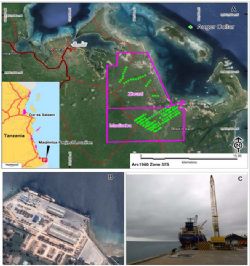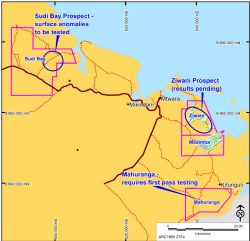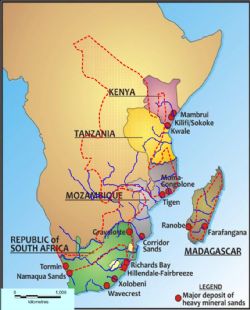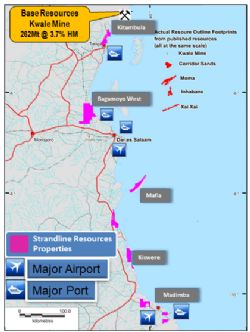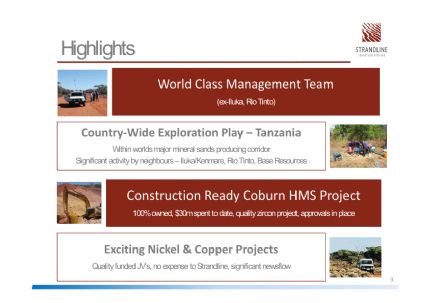
Drilling Success at Southern Tanzanian Mineral Sands Project
Perth, Feb 5, 2015 AEST (ABN Newswire) - Strandline Resources Limited ( ASX:STA) ("Strandline" or the "Company") advises that the first batch of assays from the maiden auger drilling (to an average depth of only 6m) at its 100%-owned Madimba Project (PL 9970/2014) in southern Tanzania confirm extensive zones of THM mineralisation starting from surface, with several holes ending in the highest grades encountered.
ASX:STA) ("Strandline" or the "Company") advises that the first batch of assays from the maiden auger drilling (to an average depth of only 6m) at its 100%-owned Madimba Project (PL 9970/2014) in southern Tanzania confirm extensive zones of THM mineralisation starting from surface, with several holes ending in the highest grades encountered.
The assay results received from Madimba have confirmed earlier reported pan sample visual logs and, in some cases, materially exceeded the estimated visual logging by Strandline's geologists. Significantly the surface footprints of the anomalies show size potential for higher grade strands within the bulk tonnage mineralisation. As previously reported the mineralisation contains visible indications of valuable heavy minerals such as zircon. The shallow drilling has also shown evidence of a low slime style of mineralisation which has positive mining and processing implications.
Concentrate samples have been sent for mineral assemblage characterisation and mineral chemistry analysis with results expected by the end of February 2015. The next round of work at the Madimba Project includes a ground magnetic survey and infill auger drilling prior to an aircore (AC) drilling program to test the resource potential of the mineralisation.
Strandline Managing Director, Richard Hill said: "These exciting early results at the Madimba Project represent only the first stages of a campaign to test a series of promising regional targets in southern Tanzania generated by the Company's in-house database and regional mapping of areas never previously drill tested.
"Importantly, this first shallow investigation beneath the extensive Madimba surface anomalies is confirming the potential for mineralisation with scale and grade potential consistent with the Company's objective to discover and develop a significant resource or series of resources with high unit value close to coastal infrastructure in Tanzania." The Madimba project is located less than 20km from well-developed port facilities at Mtwara that has capacity to export containerised high unit value concentrates or sufficient acreage to set up conveyors or other methods of bulk handling concentrate. A major construction and expansion project is underway at Mtwara related to the discovery and development of onshore and offshore gas (see Figure 1) (All figures can be found in the link below).
Late in 2014 the Company completed its first auger drill program across several of its southern Tanzanian Projects, namely Madimba, Madimba East and Ziwani. The drilling was designed to test beneath the historical THM surface anomalies generated from the Company's exclusive geochemical database and recent reconnaissance sampling. As previously reported the historic HM database also has some characterisation data from the Mtwara area that yielded 55.7% TiO2 from 19 ilmenite grain samples tested. The mineral assemblage data ranged between 8% - 11% combined rutile and zircon (Z+R) grades from the valuable mineral concentrate.
A total of 115 auger holes were drilled on a broad pattern at Madimba and Madimba East comprising a total of 640m and a total of 337 samples including field duplicates. Better results from the auger drilling (to an average depth of less than 6m) include:
- 7m @ 7.06% THM from surface ending in 12.36% THM;
- 7.5m @ 4.10% THM from surface ending in 4.8% THM; and
- 6m @ 3.42% THM from surface ending in 3.31% THM.
The aim of the auger drilling program is to demonstrate sufficient scale, grade, continuity and assemblage potential of the HMS mineralisation (down hole and between holes) to move to aircore (AC) drilling and potential resource definition as soon as possible.
It is important to note that hole depths have been limited to 6m and many holes end in mineralisation (>1.5% estimated THM). Therefore, in most cases, the depth potential has not been fully tested, mineralisation remains open awaiting further testing with more sophisticated methods of drilling (such as AC).
Discussion of Results
At the +1% THM level, the anomaly at Madimba East now comprises three zones of surface anomalism extending over an area of 2.7km x 1.85km along a broad northeast trending corridor. The central Madimba anomaly extends 3km in a southeast orientation with a width of 1.5km at the +1% THM level (see Figure 2). The area is currently broadly drilled on a 400m x 400m pattern with some closer spaced drilling at 400m x 200m where elevated HMS was logged down holes. Downhole geochemical analysis has been based on 2m intervals. The local geology comprises mainly free-flowing, low slimes, quartz-rich sands at Madimba East while at Madimba the soils have slightly higher clay/slimes content. The results from the three consecutive high grade holes at Madimba East (MTPA065, 066 and 068 - see Figure 3) all end in moderate to high grade mineralisation and extend over 400m along the drill line. The orientation of mineralisation at Madimba East is currently interpreted as northeast, but is expected to be better constrained with additional infill auger drilling. With laboratory data confirming visual THM grades, deeper drilling will be required in the next phase of fieldwork to determine the depth extent of the mineralisation.
The auger drill results represent a shallow investigation of two potential models for HMS mineralisation that include high grade strand related mineralisation at Madimba East and lower grade larger scale HMS mineralisation at Madimba.
Importantly the Madimba anomalies are proximal to the regionally significant Rovuma River, which carries a large HMS sediment load derived from weathered source rocks of the Mozambique Mobile Belt. Significant results are summarised in Table 1 and all of the results presented in Appendix 2 & 3.
Future Work
The Company has submitted selected concentrate samples from Madimba for mineral assemblage characterisation and mineral chemistry analysis with results expected by the end of February 2015. The assay results for the drill program completed at the neighbouring Ziwani prospect are pending. Future on-ground activities planned for Madimba include a ground magnetic survey and infill auger drilling prior to planning an aircore (AC) drilling program to test the resource potential of the mineralisation.
These exciting early results at the Madimba Project represents only the first stages of a campaign to test a series of regional targets in southern Tanzania generated by the Company's in-house database and regional mapping of areas never previously drill tested (see Figure 4).
Strandline Resources still has many other HMS anomalies along the Tanzanian coast and Mafia Island that require first pass examination and auger drilling. It remains the Company's objective to complete this important first round of auger drilling across the projects to assist in prospect prioritisation and definition of anomalies with the size and grade potential to generate a significant HMS resource or series of Resources close to coastal infrastructure.
About Strandline's 100% owned Tanzanian Mineral Sands Projects
Strandline now controls a dominant (2000km2) mineral sands exploration position along the coast of Tanzania, within a major world class mineral sands corridor. This is the result of careful targeting over a three year period. These projects are surrounded by some of the world's major world-class mineral sands mines, located in neighbouring Kenya, Mozambique, Madagascar and South Africa (see Figure 5).
Prospective areas held by Strandline include five projects along the coast where tenure contiguously covers +35-50km of coastline exposure, cumulatively ~200 km strike, and all targets are within 20kms of the coast, close to ports and other key infrastructure (Figure 6). Given the extent and location of these target areas and the strong historical evidence, Strandline is targeting scalable, high grade, high quality, high value mineral assemblages (ilmenite, rutile and zircon) close to infrastructure that have potential to be rapidly brought into production.
To view tables and figures, please visit:
http://media.abnnewswire.net/media/en/docs/ASX-STA-709043.pdf
About Strandline Resources Limited
 Strandline Resources is an Australian Stock Exchange listed company (ASX:STA) (OTCMKTS:STQNF) is a Tanzanian-focused mineral sands developer positioned within the world’s major zircon and titanium producing corridor in South East Africa. Strandline has a dominant mineral sands position with a series of 100% owned projects spread along 350km of the Tanzanian coastline.
Strandline Resources is an Australian Stock Exchange listed company (ASX:STA) (OTCMKTS:STQNF) is a Tanzanian-focused mineral sands developer positioned within the world’s major zircon and titanium producing corridor in South East Africa. Strandline has a dominant mineral sands position with a series of 100% owned projects spread along 350km of the Tanzanian coastline.
Strandline’s strategy is to develop and operate quality, low cost, expandable mining assets with market differentiation. Leveraging off the exploration success of 2016, the Company’s focus is to continue its aggressive exploration and development strategy to progress economically attractive projects based on high unit value titanium and zircon products.
| ||
|



